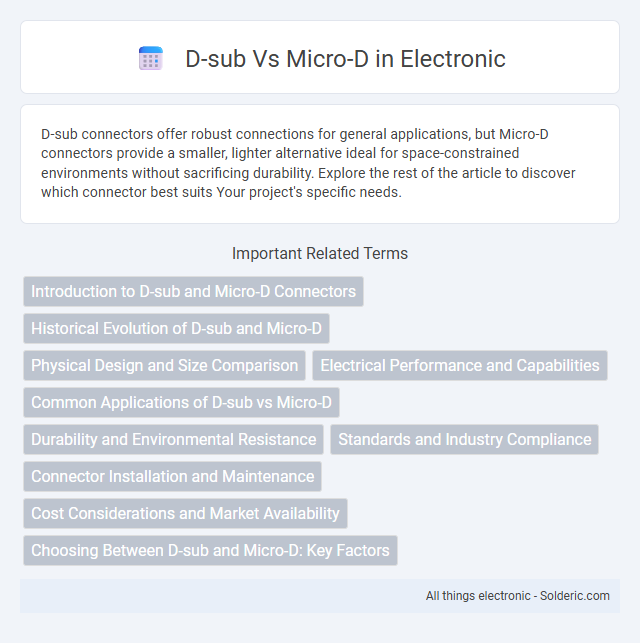D-sub connectors offer robust connections for general applications, but Micro-D connectors provide a smaller, lighter alternative ideal for space-constrained environments without sacrificing durability. Explore the rest of the article to discover which connector best suits Your project's specific needs.
Comparison Table
| Feature | D-sub Connector | Micro-D Connector |
|---|---|---|
| Size | Larger, bulkier design | Smaller, compact size |
| Pin Count | Typically 9 to 37 pins | Up to 100 pins in smaller form |
| Application | General-purpose, computer interfaces | Aerospace, military, space-grade applications |
| Durability | Standard mechanical robustness | High durability, shock and vibration resistant |
| Weight | Heavier | Lighter, suited for weight-sensitive use |
| Cost | Lower cost, widely available | Higher cost due to specialized design |
| Electrical Performance | Standard signal integrity | Enhanced signal reliability and EMI resistance |
Introduction to D-sub and Micro-D Connectors
D-sub connectors, widely used in computer and telecommunications equipment, feature a D-shaped metal shield that ensures secure connections and minimizes electromagnetic interference. Micro-D connectors offer a smaller, more compact design with high-density contacts ideal for aerospace and military applications requiring reliable performance in constrained spaces. Both connectors provide robust mechanical stability, but Micro-D excels in environments demanding weight reduction and space efficiency.
Historical Evolution of D-sub and Micro-D
D-sub connectors were first introduced in the 1950s as a rugged solution for military and industrial applications, featuring a D-shaped metal shield to ensure correct orientation and reliable connectivity. Micro-D connectors evolved from this design to meet the demands of modern aerospace and defense industries, offering a more compact footprint while maintaining the durability and electromagnetic compatibility of traditional D-sub connectors. Your choice between the two depends on space constraints and application requirements, with Micro-D providing advanced miniaturization without sacrificing performance.
Physical Design and Size Comparison
Micro-D connectors feature a smaller, more compact physical design compared to traditional D-sub connectors, making them ideal for applications requiring space-saving solutions. The reduced size of Micro-D connectors enhances your device's portability without compromising durability or pin density. This size comparison highlights how Micro-D connectors are preferred in aerospace and military applications where minimized weight and space are critical.
Electrical Performance and Capabilities
Micro-D connectors offer superior electrical performance compared to standard D-sub connectors due to their smaller contact pitch, which reduces signal crosstalk and enhances high-frequency capabilities. The compact design of Micro-D connectors supports higher density connections without compromising signal integrity, making them ideal for aerospace and military applications requiring reliable data transmission. Your choice of Micro-D connectors can improve system performance by maintaining consistent electrical continuity and minimizing impedance mismatches in demanding environments.
Common Applications of D-sub vs Micro-D
D-sub connectors are commonly used in computer interfaces, industrial equipment, and telecommunications due to their robust design and versatility in handling multiple signal types. Micro-D connectors, favored in aerospace, military, and medical devices, offer a smaller footprint and higher-density contact arrangements suitable for applications requiring compact, lightweight, and reliable connections. Your choice between D-sub and Micro-D should consider space constraints and environmental durability specific to your application's requirements.
Durability and Environmental Resistance
Micro-D connectors offer superior durability compared to traditional D-sub, featuring gold-plated contacts and robust metal shells that withstand intensive mating cycles and reduce wear. Their compact size enhances environmental resistance by providing better sealing against dust, moisture, and vibration, making them ideal for harsh or mobile environments. When selecting connectors for extreme conditions, your choice of Micro-D ensures enhanced protection and long-lasting performance.
Standards and Industry Compliance
D-sub connectors conform to established MIL-DTL-24308 standards, ensuring compatibility in aerospace, military, and industrial applications. Micro-D connectors adhere to tighter MIL-DTL-83513 specifications, providing high-density, ruggedized solutions ideal for space-constrained environments and defense systems. Both connector types meet rigorous industry compliance requirements for durability, electromagnetic interference shielding, and environmental resistance.
Connector Installation and Maintenance
D-sub connectors feature larger pins and housings, making installation easier but bulkier, while Micro-D connectors offer compact designs with fine-pitch contacts suited for tightly packed electronics. Micro-D connectors require precise alignment during installation to avoid damaging the smaller, more delicate pins. Maintenance of Micro-D connectors demands careful handling and specialized tools due to their size, whereas D-sub connectors tolerate more manual handling and are generally easier to service in rugged environments.
Cost Considerations and Market Availability
D-sub connectors generally offer lower manufacturing costs due to established production processes and widespread availability in various sizes and configurations, making them a cost-effective choice for many applications. Micro-D connectors, designed for high-density and rugged environments, often come at a premium price because of their specialized materials and precision engineering, limiting market availability primarily to aerospace, military, and high-reliability industrial sectors. Market availability for D-sub connectors is extensive with numerous suppliers worldwide, whereas Micro-D connectors have more restricted distribution through specialized vendors serving niche industries.
Choosing Between D-sub and Micro-D: Key Factors
Choosing between D-sub and Micro-D connectors depends primarily on space constraints, with Micro-D offering a more compact design ideal for high-density electronic applications. Consider the durability requirements and pin count needed for your project, as Micro-D connectors provide enhanced ruggedness and higher pin density in a smaller footprint compared to standard D-sub connectors. Your decision should also evaluate environmental factors and mechanical stress, where Micro-D connectors excel in harsh or vibration-prone settings.
D-sub vs Micro-D Infographic

 solderic.com
solderic.com